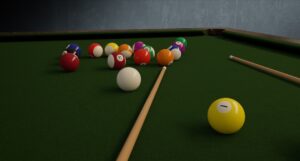There’s a lot to know about pool table sizes, as each size has different dimensions that can affect the play experience in several different ways.
This short guide will cover standard-size pool tables, regulation pool tables, and smaller tables, as these are the main three types, you’ll find out on the market.
Standard-Size Table
When it comes to standard-size pool tables, people often have difficulty classifying them because they can occasionally count as regulation pool tables. While this labeling is not incorrect, it can cause confusion when regulation tables are a different type of table despite sometimes fitting the requirements of standard-size tables.
The essential characteristic of a standard-size pool table is the length, which has to sit between six and nine feet. Any pool table shorter or longer than that is not a standard-size pool table.
Generally, you won’t find many pool tables shorter than six feet, but it’s not uncommon to find tables longer than nine feet, as oversized tables are 10 feet long and snooker tables are 12 feet long.

Regulation Tables
All regulation tables have to follow a 2-to-1 ratio for their length. If a table’s length is not double its width, then it cannot fall into the category of regulation tables. This is because the main point of regulation tables is to offer a consistent playing experience regardless of the size.
Because of this, regulation tables tend to be the most popular pool tables for both casual and competitive players. If you’re thinking about getting a pool table for your home, getting one seven, eight, or nine feet in length is a good starting point, so long as it’s a regulation table. However, if you have limited space, a smaller table might be better.

Smaller Tables
Most of the time, pool tables that are six feet or shorter are “smaller” tables. These tables are not the best if you regularly play on regulation tables, as the size difference is quite noticeable, but they are great for young kids who want to play pool. The portability of smaller tables is also another aspect worth considering.
Larger pool tables are not easy to pick up and move. They generally go in a space they won’t leave, so while smaller tables are different to play on for adults, they can still make for excellent on-the-go entertainment.

So, What’s the Best Size?
There are pros and cons to all pool table sizes. Each of them is a good option depending on what you’re looking to get out of a table, but if you’re new to pool tables, you’ll likely want to start by getting a regulation table.
The main reason for this is that regulation tables are the most common type. By owning one of your own, you’ll have the ability to play pool at most locations outside your home because they will also have regulation tables.
However, consider if you have the space for a regulation table first or if you need to go with a smaller table. This is a necessary step everyone should take, as the last thing anyone wants is to purchase a pool table and then not have it fit in their desired space.

